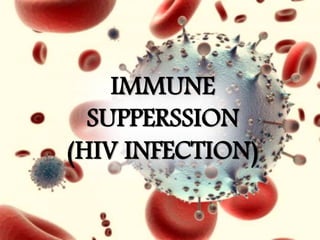
Biology :Immune Suppression (HIV)
- 2. • Acquired Immune Deficiency Syndrome (AIDS) is a type immune suppression which cripples the human immune system and the ability of the human body to resist infections diseases. • It is caused by the human immunodeficiency virus (HIV). • HIV is a type of retrovirus of an comprises of an envelope studded with glycoprotein. This envelope surrounds a protein coat which contains the viral genetic material • The enzyme reversed transcriptase enables the virus to make DNA from its RNA template, and thus earns its name as a retrovirus. • HIV destroys large portions of the T4 cells by using the glycoproteins in its envelope to recognize and bind to receptor molecules (CD4) on the T4 cells (host cells) Two molecules of single-stranded RNA and an enzyme is reversed transcriptase
- 5. INFECTION
- 6. • During infection, HIV enters the body of a person and attaches to CD4 receptor on the membrane of the T4 cell and fuses with the plasma membrane of these host cells. • The coat proteins are removed by enzymes and the RNA molecules and reverse transcriptase of HIV enter the host cells. • Reversed transcriptase catalyzes the synthesis of a single DNA strand complementary to the viral RNA strand. A second DNA strand complementary to the first is then formed catalyzed by the same enzyme. • The double-stranded complementary DNA (cDNA) is incorporated as a provirus into the T4 cell’s chromosomal DNA, where it may lie dormant for many years. This is where the HIV virus busy spreading and killing other lymphocytes
- 7. • The provirus is transcribed into RNA when the T4 cells become activated as the body of the infected person responds to certain infection. • This Viral RNA serves as both messenger RNA for the formation of HIV proteins and as genetic material for the new generations of viruses formed. • Protein coats form around the viral RNA and reverse transcriptase molecules to form new viruses.
- 10. • Viruses bub from the host cell, acquiring envelopes from the plasma membrane of the host cell ? as they leave. • The new generations of viruses are released into the blood of the infected person • This new population of HIV then attacks other T4 cells, particularly those in the lymph nodes. • As more and more of the T4 cells are destroyed, the immune system of the infected person deteriorates, making that person susceptible to various infections. This will eventually lead to death. • HIV also infects the brain cells of the infected person causing them to be gradually damaged. The retrovirus also attacks the bone marrow and causes the precursor cells in blood tissue to become a “pool” for HIV .
- 11. SYMPTOMS OF AIDS
- 12. SYMPTOMS DESCRIPTION 1. No symptoms as a carrier During the initial stages of the infection, the infected person does not show any symptoms of the disease (HIV STILL SPREADING) 2. (i) Fever (ii) Drastic loss of weight (iii) cough (iv) Fatigue (v) Diarrhea (vi) Candidiasis (vii) Swollen lymph nodes These occur at the 2nd stage of the infection 3. (i) Pneumonia (ii) Kaposi’s sarcoma (iii) Lymphoma (iv) Mental disturbance These occur at the 3rd stage of the infection. 4. Death X_X Occurs within the next two years after the infected person has develop full-blown AIDS in five years.
- 15. CANDIDIASIS
- 17. PNEUMONIA
- 18. KAPOSI’S SARCOMA
- 19. Lymphomas are a group of blood cell tumors that develop from lymphatic tissues
- 20. TRANSMISSION
- 21. • HIV is found in the blood , semen or vaginal fluids of the carrier. • Transmission can occur during blood transfer, transfer of semen or vaginal from the carrier to person through the following ways :- (i) By having multiple sex partners who could be HIV carriers. (ii) By sharing of needles or syringes with an HIV carrier. (iii) Transfer of HIV by a mother who is a carrier to her fetus through the placenta before birth. (iv) Blood transfusions from a carrier the recipient.
- 22. DRUG TREATMENTS
- 23. • Reverse transcriptase inhibitors such as Azidothymidine (AZT) and Dideoxyinosine (DdI) are used to inhibit the reproduction of virus by blocking the formation of DNA from viral RNA. • Protease inhibitors such as Ritonavir and Indinavir are used to block cleavages that convert new viral proteins into building blocks for new viruses.
- 26. PREVENTION
- 27. • Use of condoms during intercourse for people with multiple sex partners which can prevent the virus from infecting others. • Restriction to one sexual partner only that is, sex between husband and wife. • Prevent drug abuse and avoid sharing needles and syringes. • Screen all donated blood for the presence of anti- HIV antibodies. • Avoid sharing shaving razor or toothbrushes or any personal stuff which could be contaminated with HIV-infected blood. • Educate the public about the disease .
